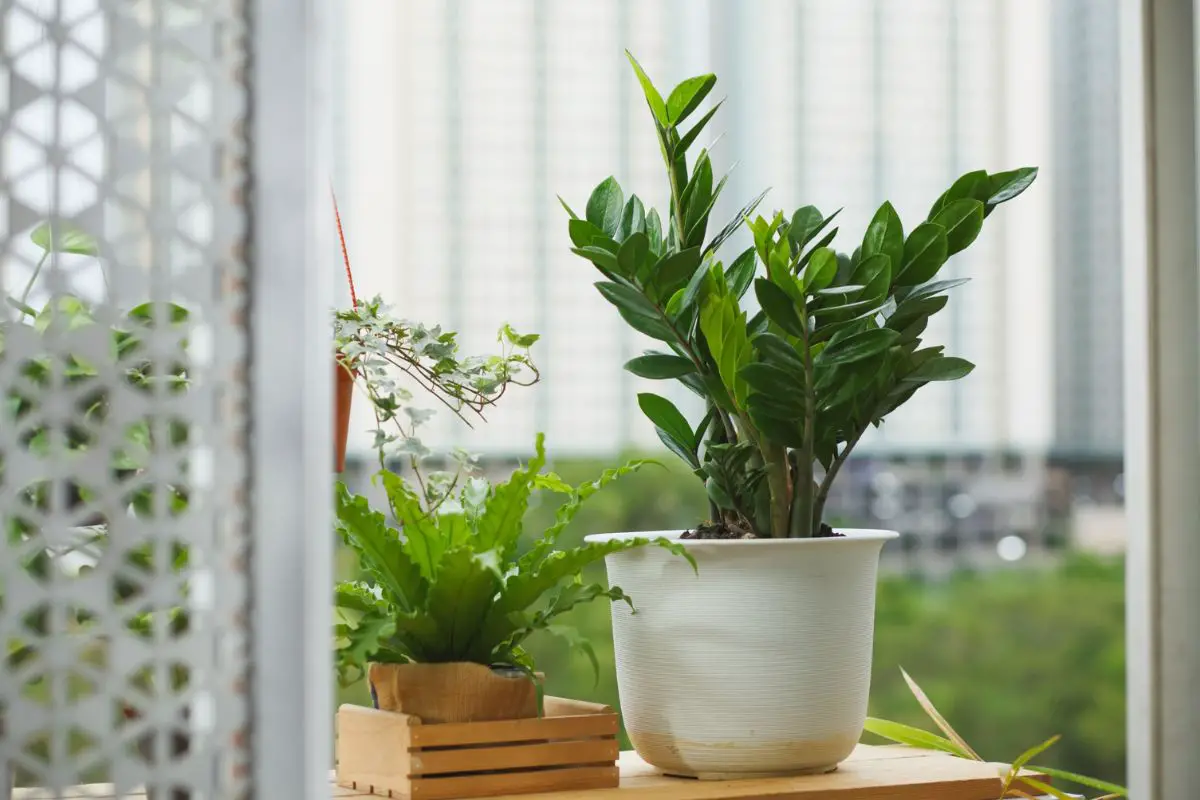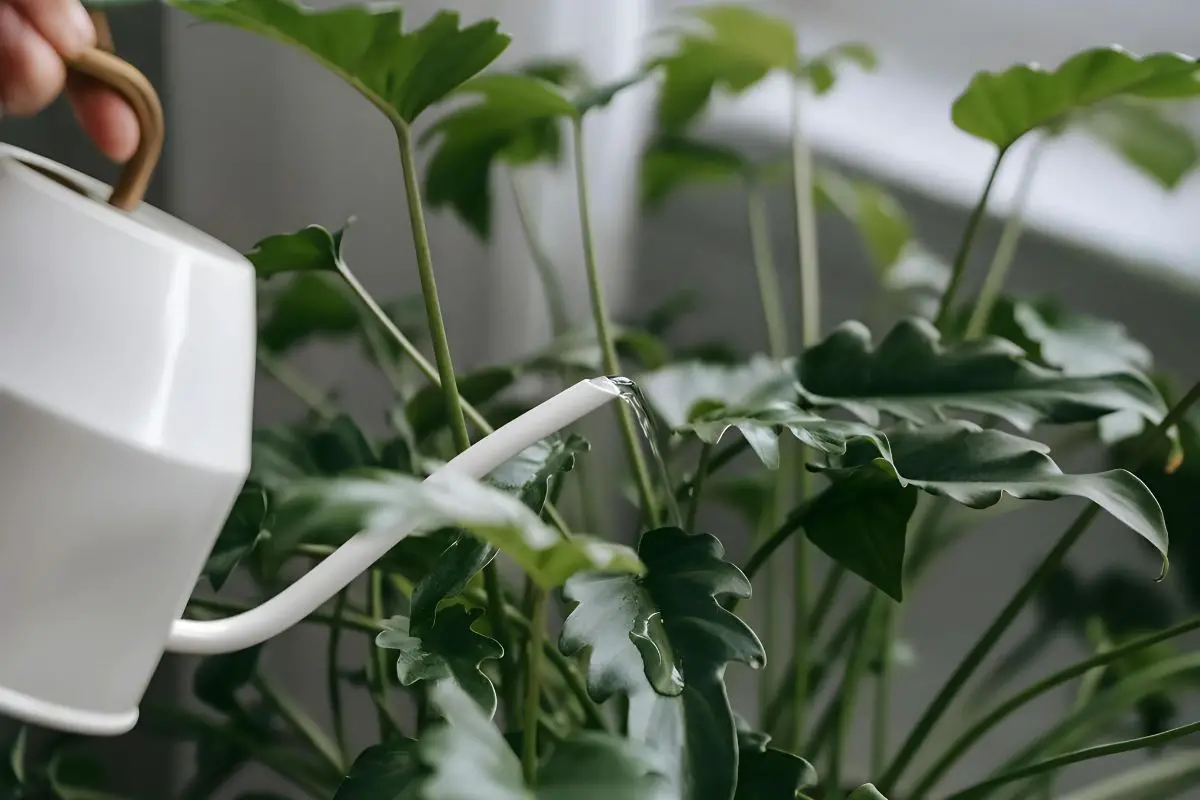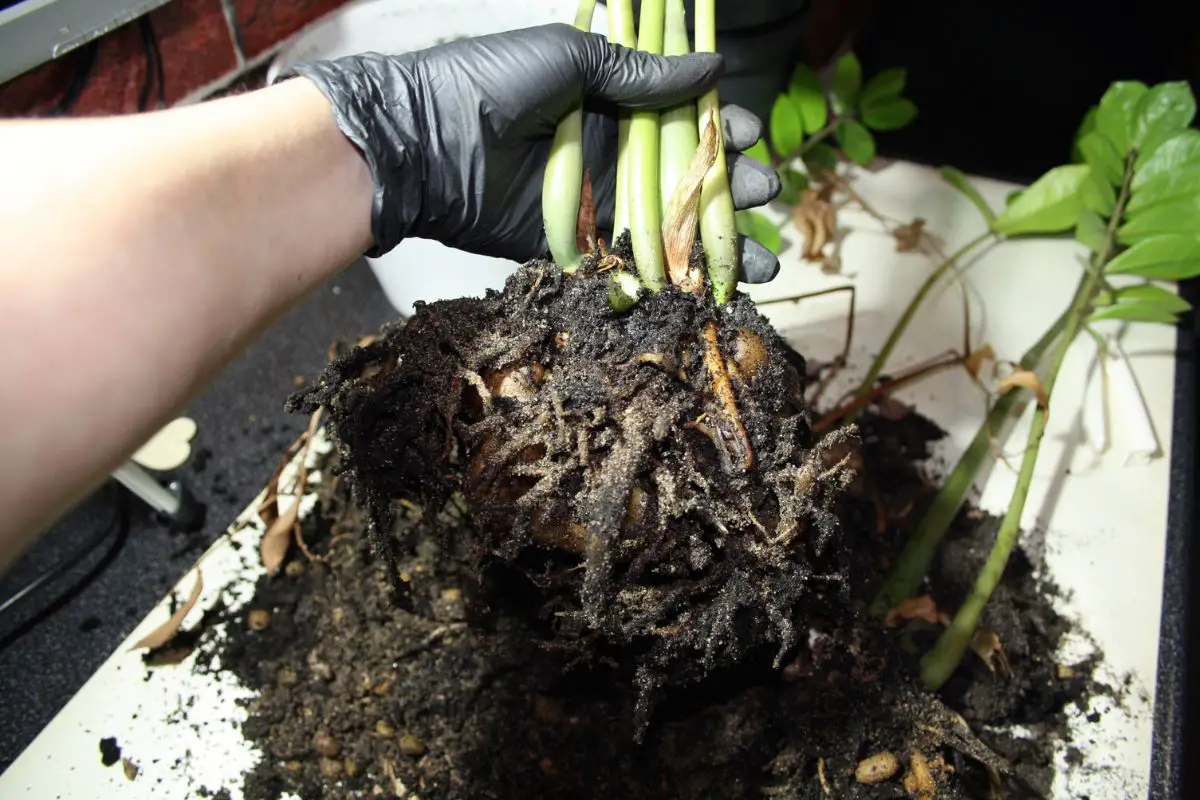ZZ plants are generally recommended for beginner gardeners due to their lush foliage and low maintenance requirements. Another important benefit of growing them is their natural resistance to common houseplant pests.
You may occasionally encounter the following pests on or around your ZZ plant:
- Aphids
- Mealybugs
- Scale insects
- Spider mites
- Thrips
- Fungus gnats
In this article, I’ll discuss how ZZ plants naturally ward off pests and what situations make them vulnerable to pest attacks. I’ll also share some tips on how to manage or eliminate these insects to maintain your plant’s health and beauty.

ZZ Plants: An Overview
ZZ plants (Zamioculcas zamiifolia) have a fascinating anatomy that makes them durable and popular houseplants.
They came from the tropical East and South African regions like Tanzania and Kenya. Their native habitat has sandy soil and sporadic rains, with taller trees or shrub canopies providing shade.
Because of these environmental conditions, ZZ plants have developed fleshy roots, rhizomes, and stems, which can efficiently absorb and store moisture.
The high moisture or sap content in their stems and leaves should attract sap-feeding or chewing insects. However, ZZ plant shoots contain calcium oxalate crystals that naturally irritate pests due to their shape.
Once pests feed on the sap and consume the crystals, the damage in their gut can either kill them or prevent them from reproducing. This mechanism effectively controls pest populations around ZZ plants.
Note: The same compound makes ZZ plants mildly toxic to cats and dogs and causes mild skin irritation to susceptible individuals. That’s why wearing gloves is important when pruning or handling cut ZZ plants.
Symptoms of Infestations
Stressed ZZ plants typically have drooping or yellow leaves and stunted growth, which also occur in case of a pest infestation.
You can distinguish pest damage by looking for actual pests and observing the following additional symptoms:
- Sticky, colorless residue on the leaves (honeydew)
- Sooty mold
- Tiny, brown holes with yellow margins
- White or yellow specks
- Irregular holes without scorch marks
- Silvery streaks
- Pepper-like specks
- Slime trails
- Tiny crawlers on the leaves
Each pest has a distinct appearance and can leave tell-tale signs to help you identify and treat the problem properly.
Common Pests
If there are existing pests in your indoor garden, you may see the following pests drawn to your ZZ plants:
Aphids
Aphids are among the most common and highly prolific houseplant pests. They’re small, translucent, soft-bodied insects that can be green, black, brown, or white.
They usually hide on leaf undersides or along stems or petioles. After feeding on plant sap, they release a sticky residue called honeydew. Sooty mold and ants are usually attracted to honeydew, but they don’t pose a threat to your ZZ plant.
In severe infestations, aphids can leave behind tiny holes with yellow margins on mature ZZ leaves. Young transplants, on the other hand, may have stunted growth.

Mealybugs
Mealybugs are small, cottony pests that tend to cluster in leaf axils and on stems. You can spot them from white cotton-like masses on the plant. They also leave behind honeydew after they feed.
A mealybug infestation can hardly affect mature ZZ plants. However, they can cause premature leaf drop and stunted growth in small plants or newly rooted ZZ cuttings.
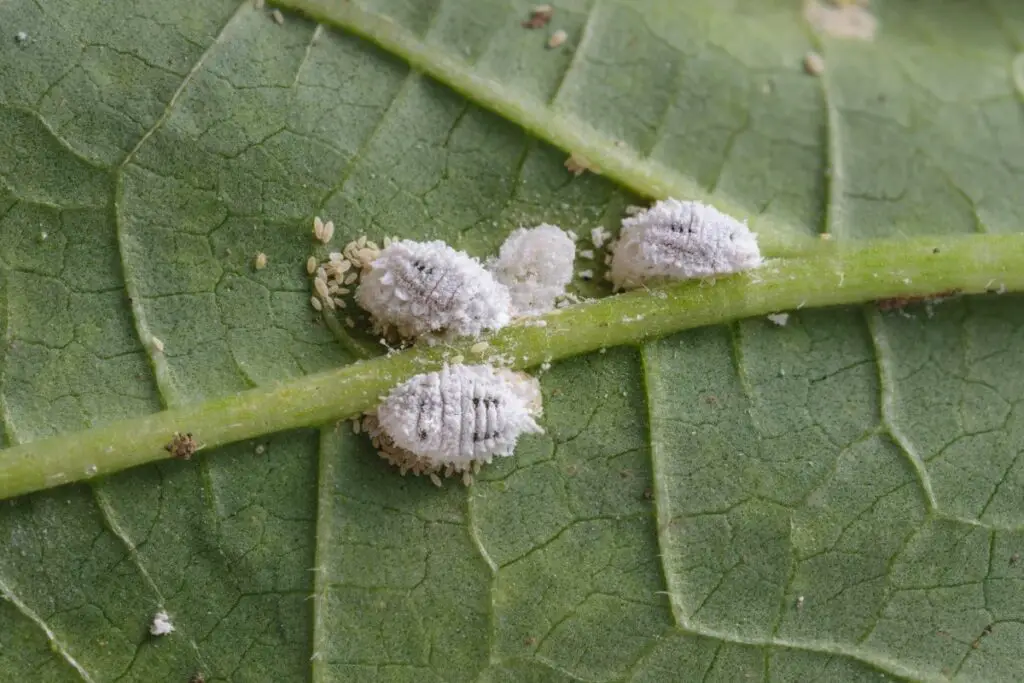
Scale Insects
Scale insects—also known as scale mites—appear as brown, immobile bumps along stems, petioles, or leaves. The crawlers, or immature stage, move around the plant before finding a permanent spot to settle in and feed.
Soft scales with cottony bodies also release honeydew that can attract sooty mold and ants.
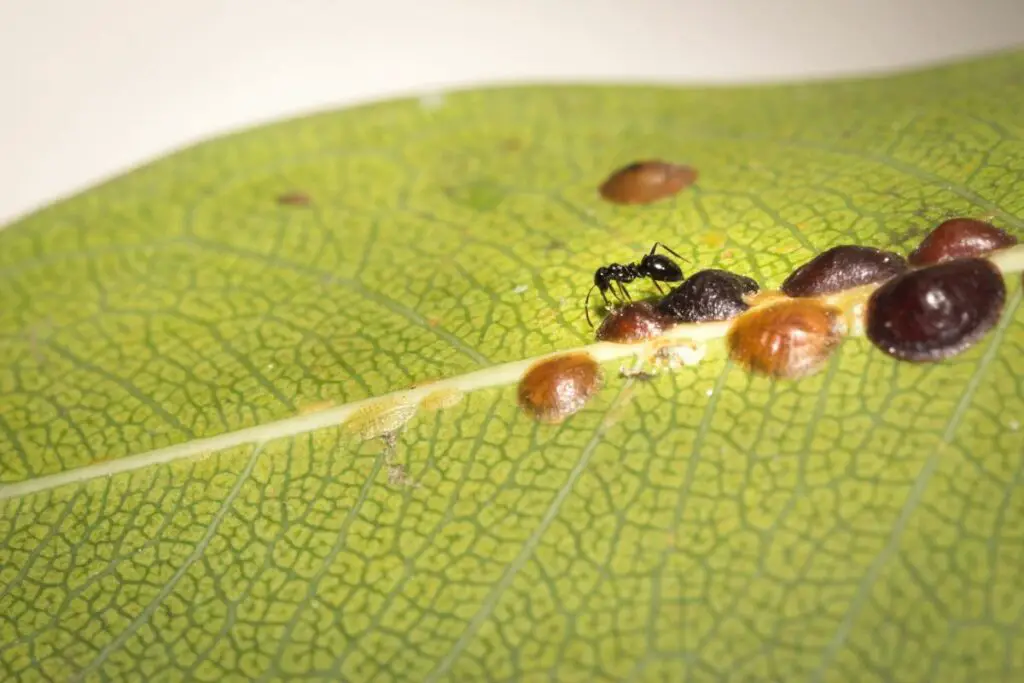
Spider Mites
Spider mites are a rare sight on ZZ plants because they prefer thin leaves. The waxy coating on ZZ leaves hardly attracts them unless there are limited options in your indoor garden.
You can easily recognize these pests through the fine webs they weave between the stems and leaves. They also look like tiny spiders and are often red or brown.
Affected leaves may appear speckled with white or yellow.

Thrips
Thrips are troublesome pests because they’re almost invisible and need a thorough inspection to identify. These winged insects like to infest plants with broad, thin leaves, such as monsteras and pothos.
If your ZZ plants are in a shady area of your home next to such plants, they’ll likely be affected by thrips as well.
You can recognize thrip damage from the silvery streaks or wounds on the leaves after they feed. They also excrete pepper-like specks close to the feeding site.

Fungus Gnats
It’s almost impossible to find fungus gnats around a well-maintained ZZ plant in relatively dry soil. Conversely, overwatered plants with constantly wet and soggy soil may be attractive to these flying insects.
Fungus gnats require a moist substrate to lay their eggs on. Overwatering can cause root rot and increase fungal populations in the soil. Once the eggs hatch, they release larvae that can feed on the fungi, the plant’s decaying roots, and any exposed bulbs.
The damage caused by gnat larvae on the plant’s root system can exacerbate the problem of root rot.

Other ZZ Plant Pests
If you take your ZZ plant outdoors for the summer, you might notice caterpillars, slugs, or snails crawling along the leaves.
Flying insects, such as butterflies or moths, can lay eggs on the plant. Once they hatch, the caterpillars can chew on the leaves and create irregular holes.
Snails and slugs may also affect ZZ plants growing in the ground or in pots outdoors. However, the coarse texture of calcium oxalate crystals may repel them after a bite and prevent severe damage to the plant.
You’ll recognize the damage from these critters based on the slime trails and irregular holes on the leaves.
Prevention and Management Strategies
Pest damage likely won’t kill mature ZZ plants, but they can negatively affect their appearance. ZZ plants are famous for their glossy green leaves and the abovementioned pests can take that away.
That said, it’s crucial to prevent these pests from attacking your plant in the first place. In case of an attack, you must be proactive with your treatment and management methods.
Let’s explore them below:
Preventive Measures
The most effective preventive measure when starting an indoor garden is to quarantine new plants for up to 8 weeks. It typically takes this long for eggs to hatch and evolve into adults, which are easier to spot, identify, and treat.
Environmental stress can weaken your plant’s resistance to pests and will make it more likely to succumb to the damage. Therefore, it’s important to observe a proper care and maintenance routine to keep your plant healthy.
To keep your ZZ plants happy,
- Avoid over- or underwatering. Check the soil around ten days after watering and water your plant as soon as the soil mix is dry halfway through. Wet soil can invite fungus gnats and cause root rot, which can lead to a myriad of problems or even plant death.
- Use a loose, well-draining soil mix. This will prevent plant stress from overwatering issues and flying pests won’t lay eggs on dry soil surfaces.
- Give your plant bright, indirect light. Too much direct sunlight can burn the leaves, whereas insufficient light can make the stems lean or leggy.
- Maintain a temperature around 75 °F (24 °C). Temperatures below 65 °F (18 °C) can stunt growth and above 85 °F (29 °C) can cause heat stress or dehydration.
- Divide your plant every 3-5 years. The poor air circulation and dense foliage of overgrown ZZ plants can invite pests and provide suitable hiding spots for them.
- Check your plant regularly for signs of pests. Use a magnifying glass to spot tiny eggs or larvae crawling underneath the leaves, along the stems, or near the soil.
- Dust or wipe the leaves with a clean, moist cloth weekly or at watering to remove honeydew, sooty mold, or pest waste.

Natural Remedies
Spot-remove pests as soon as you see them with the following tips:
- Use a cotton swab moistened with rubbing alcohol to swipe the insects into a cup of soapy water. ZZ plants have smooth leaves, making it easier to wipe off adult insects, eggs, or larvae.
- Scrape off scale mites with a blunt tool as they can be tough and firmly stick to the plant.
- Pick crawling insects, caterpillars, and snails or slugs using tweezers and drop them into a cup of soapy water.
- Place a yellow sticky trap close to your plants to catch winged pests, such as adult thrips and fungus gnats.
You can then use plant-safe natural remedies to remove the remaining eggs and larvae and prevent re-infestation.
Neem Oil Spray
Neem oil is a gardener’s favorite because it’s a safe and effective home remedy against many plant pests and fungi.
You can make a spray by mixing one tablespoon of neem oil concentrate, one tablespoon of liquid soap, and a quart (1 liter) of water.
If your ZZ plant receives direct sunlight during the day, apply the solution after sunset. In low-light conditions, you can spray your plant anytime.
Spray your plant liberally with the solution once a week for up to 6 weeks or until you can no longer find pests. Focus on the leaf undersides and on the soil surface, where pest eggs and larvae usually hide.
Pro tip: It also helps to treat the neighboring houseplants to eliminate the pests from your household completely.
Insecticidal Soap
If you have no time to handpick the pests, you can use commercially available plant-safe insecticidal soaps.
I’ve tried using homemade recipes before but found that most liquid detergents or dishwashing soaps are too harsh for ZZ plants, as they can degrade the wax on the leaves’ surface.
Pro tip: Spray the solution directly on the pests. It’s effective only on contact and has no residual effect. You may need to reapply it every 3-7 days until the pests are completely eliminated.
I personally don’t use insecticidal soaps because they’re not effective against flying insects. They also don’t work against hard-shelled scale mites.
Chemical Treatments
In rare cases where houseplant pests have gotten out of control, you may need to hire professionals or use chemical treatments.
Imidacloprid is a popular plant pesticide that works against common ZZ plant pests, such as aphids, mealybugs, and scale mites. Its residual effect lasts several months, meaning you don’t have to repeat applications as often.
However, you must take your plants to a well-ventilated and shaded spot outdoors before applying the treatment.
Carefully read and follow the product label for the proper dosage and application instructions.
Integrated Pest Management (IPM)
To properly manage pests in your indoor garden, you may integrate natural and chemical control methods with these steps:
- Isolate the severely affected plants right away. You may need to treat them with chemical pesticides like imidacloprid.
- For mildly infested plants, manually remove and eliminate visible pests using alcohol-dipped cotton swabs and soapy water. Spray the plant with neem oil solution weekly as treatment and preventive method.
- Return the isolated plants to the usual spot only when the pest issues have been resolved.
Here’s a brief summary of the common ZZ plant pests and their corresponding symptoms and treatment:
| Pest | Distinct Appearance | Symptoms and Damage | Treatment or Management |
| Aphids | Translucent green, brown, black, or white body | Sticky residue (honeydew), often with sooty mold Tiny holes with yellow margins on the leaves Leaf yellowing Premature leaf drop in small ZZ plants | Manual removal using tweezers or cotton swabs Neem oil or insecticidal soap spray Imidacloprid as a last-resort treatment option in case of severe infestation |
| Mealybugs | Cottony white wax covering | ||
| Scale Mites | Tiny brown immobile bumps that occasionally have cottony cover | ||
| Spider Mites | Tiny red or brown spider-like insects | Fine webs between stems or over leaf surface Speckled white or yellow leaf surface | |
| Thrips | Slender, winged insects; the larvae are translucent and almost microscopic | Silvery streaks or scars along the leaves Pepper-like waste | Yellow sticky traps to catch winged adults Neem oil spray on leaves and soil to kill eggs and larvae Avoid overwatering your plant to keep the soil surface a bit dry |
| Fungus Gnats | Mosquito-like adults and translucent larvae ⅛-¼ inch (3-6 mm) long | Larval feeding on roots and bulbs contributes to root rot and the consequent dehydration of shoots | |
| Caterpillars | Plump larvae of butterflies or moths that can come in different colors | Irregular holes on the leaves | Manual removal using tweezers Relocate to a different part of the garden because butterflies and moths play important roles in the ecosystem |
| Slugs and Snails | Soft-bodied, legless pests with two antennae on the head; snails have shells | Slimy trails on leaf surface Irregular holes on the leaves | Manual removal by hand or using tweezers Drop in soapy water Slather petroleum jelly with salt around pots to keep slugs and snails from climbing |
Final Thoughts
ZZ plants typically have few pest problems due to the calcium oxalate crystals in their sap that serve as a natural defense and repellent against common pests.
However, stressed or young ZZ plants are vulnerable to pest attacks, which can worsen the initial cause of stress or even kill them.
Early detection and proactive integrated management methods are crucial to prevent pest infestations from getting out of control. Otherwise, the pests can harm not only the susceptible plants but also your ZZ plants.
If you’ve encountered pest issues with your ZZ plants before, please share some insights on how you overcame the problem. Or, feel free to reach out if you have questions. Don’t forget to subscribe for more plant care tips!




